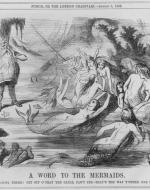Created by Natalie Evjen on Mon, 10/28/2019 - 23:24
Description:
Beginning in 1857, efforts were made to lay cable through the Atlantic Ocean and connect Europe with North America. On the fifth attempt in July 1858, four ships--the Agamemnon (pictured), the Valorous, the Niagara, and the Gorgon---met mid-ocean and connected the cables. (There are some parallel to draw here between this event and the Golden Spike connecting the transcontinental railroad in Northern Utah). The wire itself was copper and covered with gutta percha, which is a Malaysian tree gum that protected the conductivity of the copper. The demand for gutta percha led to severe deforestation in Malaysia.
This event inspired poetry and other works of literature (in the same way text messaging and the internet are often in the spotlight in contemporary pop culture). One poem, "The Atlantic Wedding Ring," compares America to a bride and England to a bridegroom, and quotes the New Testament scripture: "What God has joined, let no man put asunder." Another example is Henry James's Portrait of a Lady.
Picker, John M. “Threads across the Ocean: The Transatlantic Telegraph Cable, July 1858, August 1866.”BRANCH: Britain, Representation and Nineteenth-Century History. Ed. Dino Franco Felluga. Extension of Romanticism and Victorianism on the Net. Web. Accessed from BRANCH Oct. 28th, 2019.




